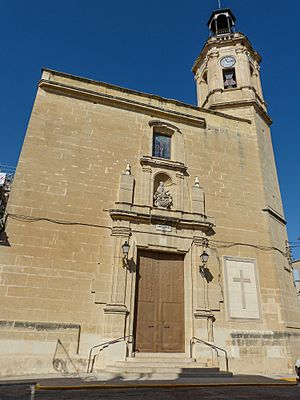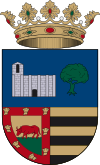La Pobla del Duc facts for kids
Quick facts for kids
La Pobla del Duc
|
|||
|---|---|---|---|

The parish church of the Ascension
|
|||
|
|||
| Country | |||
| Autonomous community | |||
| Province | Valencia | ||
| Comarca | Vall d'Albaida | ||
| Judicial district | Ontinyent | ||
| Area | |||
| • Total | 18.9 km2 (7.3 sq mi) | ||
| Elevation | 243 m (797 ft) | ||
| Population
(2018)
|
|||
| • Total | 2,537 | ||
| • Density | 134.2/km2 (347.7/sq mi) | ||
| Demonym(s) | Poblà, poblana | ||
| Time zone | UTC+1 (CET) | ||
| • Summer (DST) | UTC+2 (CEST) | ||
| Postal code |
46840
|
||
| Official language(s) | Valencian | ||
La Pobla del Duc is a small town, also called a municipality, in Spain. It is located in the region of Valencia, specifically in an area known as Vall d'Albaida. This town is a part of the beautiful Valencian Community.
Contents
Exploring La Pobla del Duc's Location
La Pobla del Duc is located near the Albaida river. The weather here is Mediterranean, which means it has warm, dry summers and mild, wet winters.
Getting to La Pobla del Duc
If you are coming from Valencia, you can reach this town by car. You would take the A-7 highway, then connect to the CV-40, followed by the CV-60, and finally the CV-611. You can also travel by train. The Renfe Media Distancia line 47 goes through here. This line is also known as the Valencia-Xàtiva-Alcoy line.
Neighboring Towns
La Pobla del Duc shares its borders with several other towns. All of these towns are in the province of Valencia. They include Bèlgida, Beniatjar, Benigànim, Castelló de Rugat, Quatretonda, Llutxent, Otos, and Sempere.
A Look at La Pobla del Duc's History
Long ago, there were farmhouses in this area built by Muslims. After King Jaime I of Aragon conquered the land in the mid-1200s, he allowed a new town to be founded. He gave a special document called a Carta Puebla to a feudal lord named Mister Belvis. This document officially recognized the new town in the Kingdom of Valencia.
Later, this land was given to the Dukes of Gandía. These dukes belonged to the House of Borja. This is why the town is now called "La Pobla del Duc," which means "The Town of the Duke."
Economy and Local Activities
For many years, growing grapes for wine was the main way people in La Pobla del Duc made a living. However, things have changed over time. Now, much of the land is used to grow fruit trees. You can find plum, peach, and apricot trees here.
The town also has several farms that raise chickens and pigs. About 200 sheep graze freely in the countryside. In recent years, the industrial sector has grown. However, farming and food-related businesses are still more important to the town's economy.
Important Places to Visit
La Pobla del Duc has several interesting historical sites.
- Manor Houses: You can still see many old manor houses in the town. They have a simple, traditional style that shows off their Mediterranean charm.
- Parish Church: This church is dedicated to Nuestra Señora de la Asunción. It has a rectangular shape and a tower with six sides.
- Calvary Garden: This is a beautiful garden that is worth visiting.
- The Poasa: This is an ancient well. It is believed that the first people who settled in this area used this well for water.
- Convent of Minimus: This convent was founded in 1603. It was built on the site of an older hermitage dedicated to San Sebastian and San Fabián, located outside the town. In 1835, due to changes in laws, the building was given to the town hall, which later took it down. The original church of the convent was dedicated to San Cosme and San Damián. Today, only a few arches from the gates remain, which are now part of a small park and garden.
Local Celebrations and Festivals
The people of La Pobla del Duc enjoy celebrating their traditions.
- Patronal Feasts: The town celebrates its main festivals in September. These celebrations honor the Christ of the Amparo, San Blas, and the Divine Dawn.
- Civic Feasts: In recent years, the town has started new fun activities for everyone. One popular event is the Food and Commercial Fair of Puebla del Duc, called "Bon profit i bona gana." This fair is enjoyed by both children and adults.
See also
 In Spanish: Puebla del Duc para niños
In Spanish: Puebla del Duc para niños




